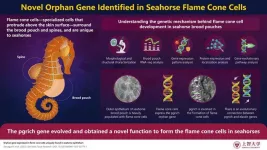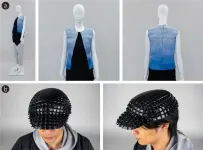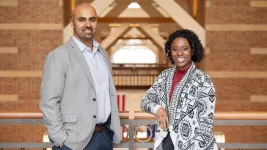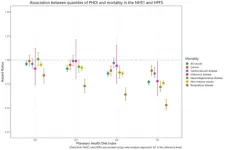(Press-News.org) Teleost fish encompass a diverse group, among which seahorses display a unique morphology. The characteristic spines and brood pouch seen in seahorses feature distinctive epithelial cells—called flame cone cells—covered by a mucous cap. However, these cells are not found in the barbed pipefish Urocampus nanus or the seaweed pipefish Syngnathus schlegeli, close relatives of the seahorse, belonging to the Syngnathidae lineage. While research has hypothesized the function of the flame cone cells, their evolutionary origins have remained a mystery.
Now, a team of scientists led by Assoc. Prof. Mari Kawaguchi and Prof. Shigeki Yasumasu from the Department of Materials and Life Sciences at Sophia University have identified an ‘orphan’ gene—a gene with no identifiable homologous sequences in other species or lineages—in the seahorse Hippocampus abdominalis. They believe that this gene, called the proline-glycine rich (pgrich) gene, is linked to the development of the flame cone cells in the brood pouch. Their findings were published in the journal Cell and Tissue Research, on 25 May 2023.
Expanding the reason behind pursuing this investigation, Dr. Kawaguchi says, “Seahorses have fascinating morphology, and males carry embryos in their brood pouch. The occurrence of male seahorses giving birth is a rare phenomenon in the animal kingdom and makes the seahorse a model organism to study evolution. We were keen to identify the genes responsible for forming the flame cone cells in the brood pouch.”
The team first paired histological staining with electron microscopy to confirm that the flame cone cells were present on the outer epithelium of the brood pouch in H. abdominalis, but not in U. nanus or S. schlegeli. Next, in situ hybridization and immunohistochemical methods revealed that the pgrich gene was expressed and its protein was localized in flame cone cells of the body surface.
The amino acid sequences of protein product of pgrich gene, PGrich showed partial similarity with the translated amino acid sequence deduced from the antisense strand–the noncoding part–of greater pipefish elastin gene. Through sequence analyses, the team uncovered many transposable elements around the pgrich gene. They propose that the pgrich gene might have evolved from the elastin gene in pipefish and subsequently obtained a novel function in the formation of flame cone cells, which are unique to seahorses.
As the team continues to piece together the evolution of the seahorse brood pouch, Dr. Kawaguchi concludes, “The evolutionary history of the pgrich gene may provide clues as to how the orphan gene came to be and how the brood pouch developed in this lineage. Seahorses are popular in home aquariums, and understanding these phenomena will contribute to people’s fascination with these fish!”
Reference
【Title of original paper】Orphan gene expressed in flame cone cells uniquely found in seahorse epithelium
【Journal】Cell and Tissue Research
【DOI】10.1007/s00441-023-03779-1
【Authors】Mari Kawaguchi1, Wen‐Shan Chang1, Hazuki Tsuchiya1, Nana Kinoshita1, Akira Miyaji1, Ryouka Kawahara‐Miki2, Kenji Tomita3, Atsushi Sogabe4, Makiko Yorifuji5,6, Tomohiro Kono2,7, Toyoji Kaneko3, Shigeki Yasumasu1
【Affiliations】1Department of Materials and Life Sciences, Faculty of Science and Technology, Sophia University, Chiyoda‐ku, Tokyo, Japan, 2Genome Research Center, NODAI Research Institute, Tokyo University of Agriculture, Setagaya-Ku, Tokyo, Japan, 3Graduate School of Agricultural and Life Sciences, The University of Tokyo, Bunkyo‐ku, Tokyo, Japan, 4Department of Biology, Faculty of Agriculture and Life Science, Hirosaki University, Bunkyo, Hirosaki, Aomori, 036-8561, Japan, 5Sesoko Station, Tropical Biosphere Research Center, University of the Ryukyus, Sesoko, Motobu, Okinawa, 905-0227, Japan, 6Demonstration Laboratory, Marine Ecology Research Institute, Arahama, Kashiwazaki, Niigata, 945-0017, Japan, 7Department of Bioscience, Tokyo University of Agriculture, Setagaya-Ku, Tokyo, Japan
About Sophia University
Established as a private Jesuit affiliated university in 1913, Sophia University is one of the most prestigious universities located in the heart of Tokyo, Japan. Imparting education through 29 departments in 9 faculties and 25 majors in 10 graduate schools, Sophia hosts more than 13,000 students from around the world.
Conceived with the spirit of “For Others, With Others,” Sophia University truly values internationality and neighborliness, and believes in education and research that go beyond national, linguistic, and academic boundaries. Sophia emphasizes on the need for multidisciplinary and fusion research to find solutions for the most pressing global issues like climate change, poverty, conflict, and violence. Over the course of the last century, Sophia has made dedicated efforts to hone future-ready graduates who can contribute their talents and learnings for the benefit of others, and pave the way for a sustainable future while “Bringing the World Together.”
Website: https://www.sophia.ac.jp/eng/
About Associate Professor Mari Kawaguchi from Sophia University
Dr. Mari Kawaguchi is an Associate Professor in the Department of Materials and Life Sciences, Faculty of Science and Technology at Sophia University. Her area of interest is evolutionary biology, and she is studying the developmental and evolutionary processes of brood pouches in seahorses and pipefish. Dr. Kawaguchi has published over 40 peer-reviewed articles since 2003.
Funding information
Funding was in part through a Grant-in-Aid for Scientists (C) (19K06793 and 22K06344) to M. Kawaguchi and by a Cooperative Research Grant of the Genome Research for BioResource, NODAI Genome Research Center, Tokyo University of Agriculture to M. Kawaguchi, R. Kawahara-Mika, and T. Kono.
END
According to an analysis of the UK’s cosmetic injectables industry by UCL researchers, 68% of cosmetic practitioners who are administering injections such as Botox are not qualified medical doctors.
The study, published in the Journal of Plastic, Reconstructive & Aesthetic Surgery, is the first survey of who is providing cosmetic injectable services, such as Botulinum Toxin (Botox) and Dermal Fillers, in the UK. Currently, little is known about the background qualifications, training and experience levels of those who are administering treatments.
To fill this ...
3D printing of complex objects typically takes a long time due to the printing process necessarily laying down a large number of 2D layers to build up the object. The process usually wastes a lot of material required to support the unfinished object. Some novel ways to make flat materials self-fold into 3D shapes exist, but have shortcomings. For the first time, researchers combined 2D printing, origami, and chemistry to create a method of rapid 3D object fabrication without creating any waste material. These shapes self-fold in seconds.
For some time, 3D printing has been used to prototype ...
A diet originally designed to help ward off cognitive decline in adults might also help improve attention in pre-adolescents, according to a new study. The findings could help inform future dietary interventions aimed at improving cognition in children.
The new study examined two diets: the Healthy Eating Index – 2015 (HEI-2015), which is based on the Dietary Guidelines for Americans, and the Mediterranean-DASH Intervention for Neurodegenerative Delay (MIND) diet, which combines the Mediterranean diet with the heart-healthy Dietary Approaches to Stop Hypertension ...
Eating more planet-friendly foods could help you live a longer, healthier life, according to new research. Researchers found that people who followed a more environmentally sustainable diet were 25% less likely to die during a follow-up period of over 30 years compared to those with a less sustainable diet.
The study builds upon prior research that identified foods that are a win-win for both health and the environment—such as whole grains, fruit, non-starchy vegetables, nuts, and unsaturated oils—as well as foods that could be harmful to the environment and human health, like eggs ...
A study of over 10,000 children in rural Pennsylvania revealed that a large proportion of children were fed foods that are high in sugar and salt in their first years of life.
Over half (53%) of the children in the study received high-sodium meats such as hot dogs, 37% received salty snacks such as potato chips, and one-third (34%) received cakes, cookies, or pudding before age 2. In addition, over one-quarter (27%) of babies received juice before their first birthday.
“Given ...
Systematic review of 8 studies in more than 7,700 serodiscordant couples in 25 countries finds people living with HIV with viral loads less than 1,000 copies/mL have almost zero risk of transmitting the virus to their sexual partners. Previous studies have not been able to confirm a lack of transmission risk above 200 copies/mL.
Systematic review also consolidates and reinforces previous studies that have found there is zero risk of transmitting the virus to sexual partners when people living with HIV have an undetectable viral load.
Of the more than 320 documented sexual HIV transmissions ...
In one of the first large-scale studies of genes related to diet, researchers have uncovered almost 500 genes that appear to directly influence the foods we eat. The findings represent an important step toward using a person’s genetics to develop precision nutrition strategies that help improve health or prevent disease.
“Some genes we identified are related to sensory pathways — including those for taste, smell, and texture — and may also increase the reward response in the brain,” said research team leader Joanne Cole, PhD, assistant professor in the Department ...
There is growing evidence that consuming prebiotics — certain types of fiber often found in plants that stimulate beneficial bacteria in your gut — can help to maintain a healthy gut microbiome. In a new study, scientists estimated the prebiotic content of thousands of food types by using preexisting literature to find out which foods offer the highest prebiotic content.
According to the study, foods that pack the greatest prebiotic punch are dandelion greens, Jerusalem artichokes, garlic, leeks, and onions. In addition to supporting gut microbes, prebiotic rich ...
A University of Texas at Arlington engineering researcher is working on defenses that could thwart cyberattacks against networks of self-driving cars and unmanned aerial vehicles.
Animesh Chakravarthy, associate professor in the Department of Mechanical and Aerospace Engineering (MAE), is the principal investigator on an approximately $800,000 U.S. Department of Defense grant titled “Resilient Multi-Vehicle Networks.” MAE Professor Kamesh Subbarao, and Bill Beksi, assistant professor ...
Using electrochemistry to separate different particles within a solution (also known as electrochemical separation) is an energy-efficient strategy for environmental and water remediation: the process of purifying contaminated water. But while electrochemistry uses less energy than other, similar methods, the electric energy is largely derived from nonrenewable sources like fossil fuels.
Chemists at the University of Illinois Urbana-Champaign have demonstrated that water remediation can be powered in part — and ...





